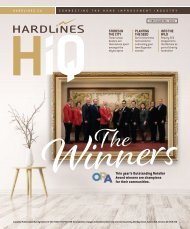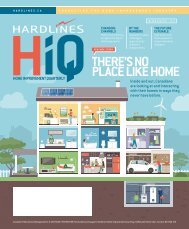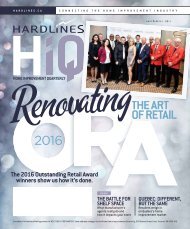HHIQ Q2
You also want an ePaper? Increase the reach of your titles
YUMPU automatically turns print PDFs into web optimized ePapers that Google loves.
BEST PRACTICES<br />
F LE<br />
with visual tools to help them understand.<br />
Communicating to the style of the listener<br />
makes for effective relationships regardless<br />
of age.<br />
Be a good listener. Listening is<br />
all about learning more about<br />
individual perspectives. Learn<br />
to understand your own listening habits<br />
such as jumping into a conversation and<br />
interrupting the speaker. Pay attention to<br />
the speaker, listen from a non-judgmental<br />
point of view and acknowledge the speaker<br />
with a nod of the head or a smile so that<br />
communication continues. Being a better<br />
listener brings about a better understanding<br />
and acceptance of differing viewpoints.<br />
Apply question thinking. Avoid<br />
being the person who has all<br />
the answers and who is always<br />
right. Learn to ask questions that create a<br />
“learner” mindset using the word “what”.<br />
What is possible, what are the choices, what<br />
“<br />
are the facts. Avoid asking questions that are<br />
more judgement-oriented such as “Why are<br />
they so slow?” This type of question puts<br />
you in the judgement mode and pushes the<br />
blame on someone else. Question thinking<br />
draws out new ideas and creates a broader<br />
level of understanding of where an individual<br />
is coming from.<br />
Respect multitasking. Younger<br />
workers will have grown up in<br />
a connected world. Many have<br />
had their own technology (iPad/iPhone)<br />
for some time. In fact, they probably have<br />
an app for everything and will quickly flip<br />
between different tools and different tasks.<br />
They’re used to a wide range of stimuli and<br />
don’t get distracted easily. This is their way<br />
of life. Respect it and take advantage of it.<br />
Don’t expect this worker to concentrate for<br />
long periods of time without touching their<br />
personal technology. They will still get the<br />
work done.<br />
Be open to change. One of the<br />
biggest complaints young people<br />
have in the workplace is that<br />
their ideas are discounted with comments<br />
like, “We already tried that” or “That won’t<br />
work here”. The challenge is that people get<br />
so entrenched in their own routine ways<br />
that they don’t want to think about making<br />
changes. However, automation and technology<br />
are making such an impact today that<br />
change is inevitable. Take time to listen to<br />
the suggestions brought forward by younger<br />
colleagues. Make sure you ask yourself<br />
“Why not?” and explore just how things<br />
can be done differently.<br />
Intergenerational workplaces offer<br />
opportunities to do things differently, to be<br />
creative and to be innovative. This kind of<br />
atmosphere creates a unique advantage that<br />
is attractive to high-performing employees.<br />
”<br />
Engage in team activities. Yes,<br />
baby boomers often think that<br />
fun has no place at work, but<br />
younger people want to have fun. So if<br />
you’re a leader, think of creative ways to<br />
bring fun and motivational activities into<br />
the workplace. Fun activities are great for<br />
really getting to know people. They create<br />
a positive atmosphere and help to build<br />
stronger relationships with the team.<br />
Grant some independence. The<br />
younger generation, as with<br />
many adults, does not work well<br />
when being micromanaged. Invite these<br />
colleagues to share how they perceive<br />
getting a job done, then delegate and leave<br />
them alone until it’s time to report progress.<br />
Quit being a parent. Without<br />
realizing it, many older workers<br />
often treat their young colleagues<br />
from a parental point of view. They do this<br />
through their tone of voice, either as a critic<br />
or as a nurturing parent. This causes frustration<br />
and resentment. Young people are usually<br />
very well educated and qualified for their<br />
jobs and don’t want to be treated like children.<br />
Avoid lecturing. Lecturing and<br />
telling your employees what they<br />
should do, why they should be<br />
doing something and telling them how life<br />
works in your organization is usually a turnoff.<br />
Unless more questions are asked, avoid<br />
lecturing to employees and colleagues. Let<br />
them come to you for your wisdom.<br />
Coaching and mentoring. Young<br />
people are voracious and quick<br />
learners and will undoubtedly<br />
ask questions. Be careful not to brush them<br />
away with the comment, “That’s how we do<br />
it around here”, but rather share the rationale<br />
behind decisions. Ask questions about<br />
their thoughts. Be a coach and mentor to<br />
help younger people belong to your team.<br />
Help them flourish.<br />
Intergenerational workplaces offer<br />
opportunities to do things differently, to be<br />
creative and to be innovative. This kind of<br />
atmosphere creates a unique advantage that<br />
is attractive to high-performing employees.<br />
Make your intergenerational and diverse<br />
work environment a focal point for attracting<br />
new employees. Provide ongoing training<br />
with a focus on relationship building.<br />
After all, people want to join organizations<br />
that are motivating and welcoming.<br />
Barbara J. Bowes, FCPHR, CMC,<br />
CCP, M.Ed., is president of Legacy<br />
Bowes Group, the author of eight<br />
books, a radio personality, speaker, executive<br />
coach and a workshop leader. She can be<br />
reached at barb@legacybowes.com.<br />
30 SECOND QUARTER / 2019<br />
Hardlines Home Improvement Quarterly<br />
www.hardlines.ca
















